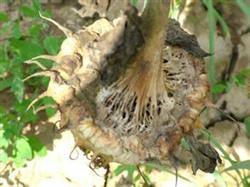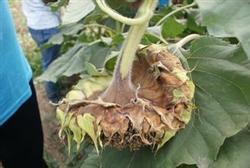Occurrence and control of Sclerotinia sclerotiorum in sunflower

With the accelerated pace of planting structure adjustment, the market demand for drug-eating sunflower seeds is increasing day by day. Sunflower is a kind of cash crop that is easy to manage, labor-saving and labor-saving. Due to the extensive field management and continuous cropping for many years, many diseases are prevalent and aggravated year by year, which directly leads to the decline of sunflower yield and threatens its production development and farmers' income. After several years of field investigation and experimental research, the occurrence and control techniques of sunflower Sclerotinia sclerotiorum are briefly introduced as follows. 1. The results of the investigation on symptoms and morbidity showed that the incidence of sunflower Sclerotinia sclerotiorum was less than 1.5% before 1996, rising to about 3% in 1998, 5% in 1999, 8% in 2002, 20.1% in 2003 and 45% in serious plots. The heavy rain in October 2003 caused a large area of sunflower lodging, aggravated the pandemic of the disease, and lost more than 30% of the yield. There are two main symptoms of the disease in our district, namely, stem rot type and flower rot type. The stem rot type can occur in all parts of the stem, and the oval brown disease spot appears on the stem surface at the initial stage, which expands gradually. After about 15-20 days, the large area black-brown disease spot forms a buckle ring around the stem, and the plant wilts and dies or dies when the wind blows. This type of symptom is most common in the middle and lower part of the stem or the neck of the ear. After flowering, water-stained light brown round disease spots appeared in the receptacle behind the disk, which expanded to the whole disk and softened the tissue, and there was no obvious stench after decomposition. Wet weather or rain will appear white mycelium, and finally form a black sclerotia, the bacteria can also infect and spread to the front of the disk, the hyphae spread among the grains, forming a black sclerotia network to cover the disk. In the later stage, the whole disk or some or all of the seeds fell to the ground due to the decay of the tissue structure of the disk. The symptoms on the grain are generally not very obvious, when serious, the pericarp decolorizes and turns white, the kernel is brown, and loses commercial and seed value. two。 The pathogen of Sclerotinia sclerotiorum is Sclerotinia sclerotiorum, Sclerotinia sclerotiorum, black. The sclerotia of the disease occurred less in the stem and more in the disk. The sclerotia could resist the adverse environment and still had vitality after 10 minutes at-40 ℃ or 55 ℃, and decayed and died only 30 days after flooding. When the conditions are suitable, the sclerotia begins to germinate, which can directly form hyphae to infect the host, and can also form an ascomycete disk to produce ascospores and ascospores. After the ascospores spread to the host surface with wind and rain, they germinate into mycelium infection and cause sunflower disease. The pathogen overwintered in soil seeds in the form of Sclerotinia sclerotiorum, the carrying rate of seeds with serious Sclerotinia sclerotiorum was more than 10%, the nuclear energy of bacteria was mixed with seeds, and the pericarp, seed coat, cotyledons and embryos could carry bacteria. After sowing, it can cause seedling death or disease in seedling root and rhizome. Most of the sclerotia in the soil are distributed in the soil layer of 0 cm. The hyphae of sclerotia germination can invade the root or rhizome of sunflower directly from the wound. The sclerotia on the surface of the soil can produce ascomycetes and release ascospores to the stems, leaves or disk with wind, rain and airflow, which can invade directly or from the wound. In the process of infection, pathogens secrete oxalic acid and some enzymes, if collagenase and lactourase promote host tissue decay and decomposition, resulting in disease symptoms. 3. Due to the serious occurrence and harm of Sclerotinia sclerotiorum in 2003, the control technology brought great hidden danger to the production of sunflower in 2004, mainly by increasing the number and density of sclerotia in seeds and soil. 3.1 the sclerotia of rotation can survive in the soil for several years, and most of its vitality will be lost after 3 years, so the rotation of sunflower and gramineous crops can greatly reduce the disease. The longer the rotation time, the better the effect, but not with legumes, cruciferous and other crops. 3.2 do a good job in pastoral hygiene to thoroughly remove diseased plants, fallen branches and leaves, diseased disk and seeds from the field, or burn them to reduce pathogens. 3.3 seed treatment introduces seeds from disease-free areas or collects seeds from healthy disk, and after selecting sclerotia to remove inclusion, 50% Sukeling wettable powder and 50% sclerotia net wettable powder can be selected before sowing, and seed dressing with 0.3% ~ 0.5% of the seed amount can achieve more than 80% of the control effect. 3.4 spraying in time after sunflower bud blossoms, in case of continuous overcast and rainy days, or the land with serious disease and stubble should be treated as early as possible. The medicine can be treated with 50% Sukeling wettable powder or 800 × 1000 times liquid, or 50% carbendazim wettable powder 500 times, or 40% sclerotia net wettable powder 500 times once every 7 days for 2 times, the control effect is significant.
- Prev

Control of sunflower sclerotia disease
To control sunflower sclerotiorum, we should pay attention to rotation and elimination of dead bodies. Encourage sunflower rotation with millet, millet, corn and other gramineous crops, avoid continuous cropping with legumes and solanaceae. The rotation period is at least 3 - 5 years. During autumn harvest, try to remove straw, dig out stubble and deeply turn more than 10 cm. The second is...
- Next

Causes and control methods of premature senescence of wheat
Causes and control methods of premature senescence of wheat
Related
- The first cup of black tea in spring, the flavor and history of tea gardens in Kenya, Africa
- The computer can not only choose potatoes, but also grow tea rice. AI will grow winter oolong tea champion.
- It is not only the inflated tea bitten by insects, but also engraved with the four seasons tea in Beipu.
- The Oriental Beauty Tea Festival in Zhuxian County takes the stage at the weekend to experience the plus-size feast of oil tea.
- & quot; Oriental Beauty Tea & Exploration of Emei in Hsinchu, the hometown of quot;
- The new variety of strawberry "Tainong 1" dessert is the first choice with mellow aroma. Crimson gorgeous
- History of Tea in Taiwan: from Wild Inner Mountain to Export Tea Garden
- Two types of Taiwan Oriental Beauty Black Tea won the British three-Star Award for Childhood Tea Xiang Zhang Jiaqi changed from pilot to champion tea maker.
- Banana species and varieties: the planting history of Taiwan Xianren banana and dwarf banana is long, is banana disease resistant?
- Coffee planting Technology: Qianjie Coffee from Seedling to harvesting

